Detailed Report: Calculating and Accounting for Impairment Loss
VerifiedAdded on 2020/03/28
|9
|1628
|36
Report
AI Summary
This report provides a comprehensive overview of impairment loss accounting, focusing on the calculation of recoverable amounts, value in use (VIU), and fair value less cost of disposal. It explains the application of IAS 36, detailing the steps involved in identifying and measuring asset impairment. The report includes practical examples, such as calculating impairment loss on a cash-generating unit (CGU), along with the relevant journal entries. It highlights the importance of recognizing impairment losses and provides insights into the accounting standards and principles that guide the process. The report also covers the allocation of impairment loss to goodwill and other assets on a pro-rata basis, ensuring a clear understanding of the financial implications of asset impairment.
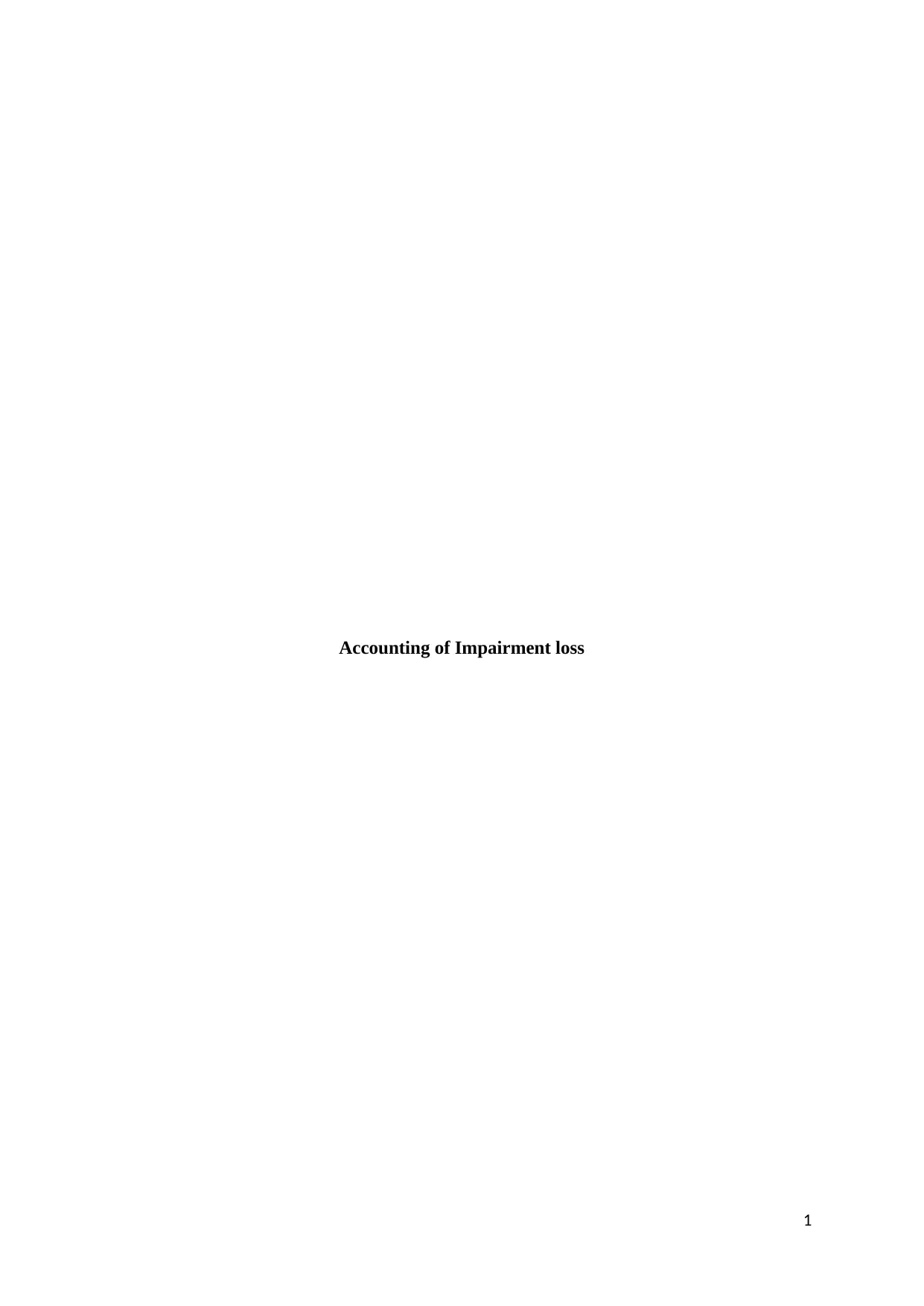
Accounting of Impairment loss
1
1
Paraphrase This Document
Need a fresh take? Get an instant paraphrase of this document with our AI Paraphraser
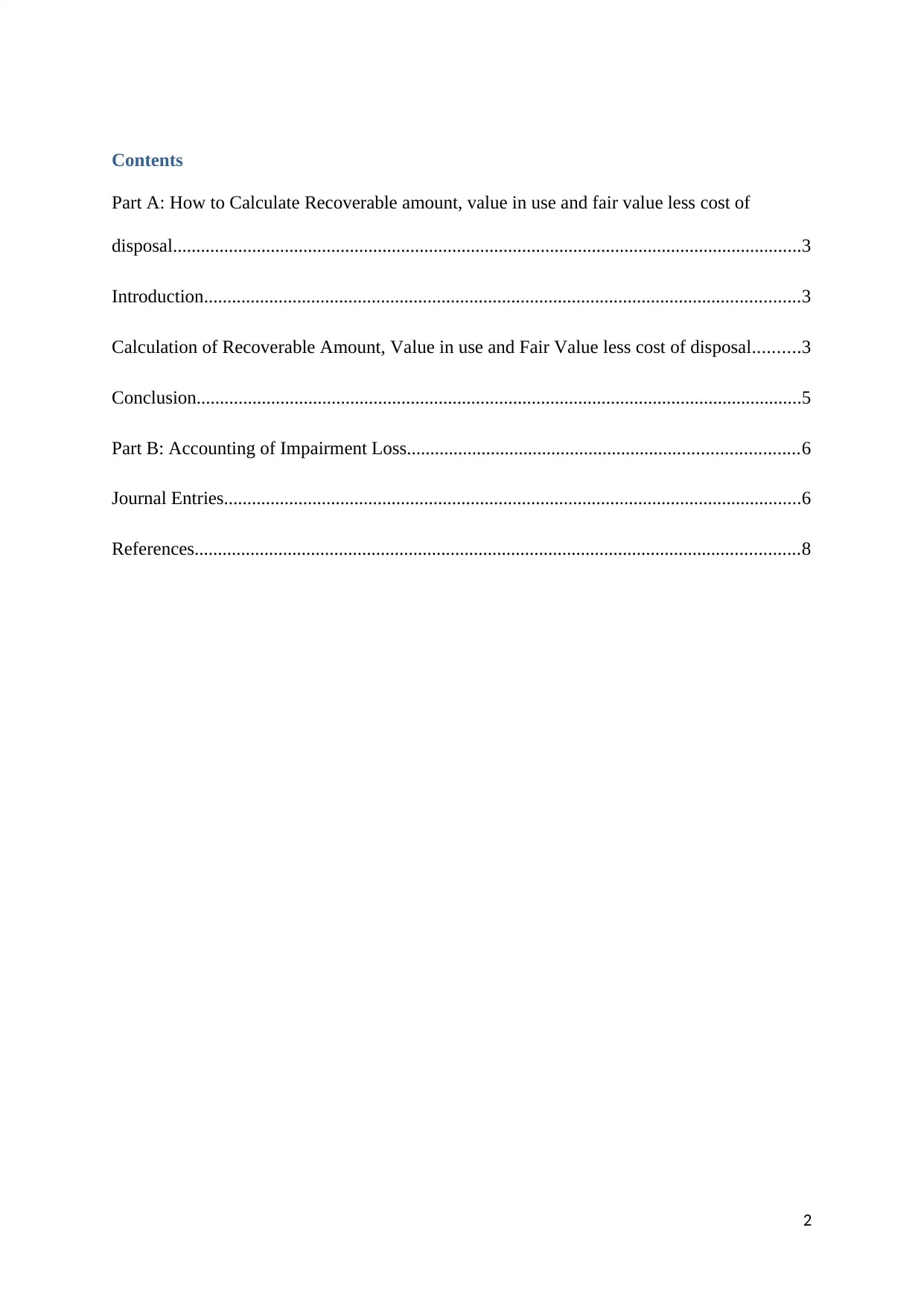
Contents
Part A: How to Calculate Recoverable amount, value in use and fair value less cost of
disposal.......................................................................................................................................3
Introduction................................................................................................................................3
Calculation of Recoverable Amount, Value in use and Fair Value less cost of disposal..........3
Conclusion..................................................................................................................................5
Part B: Accounting of Impairment Loss....................................................................................6
Journal Entries............................................................................................................................6
References..................................................................................................................................8
2
Part A: How to Calculate Recoverable amount, value in use and fair value less cost of
disposal.......................................................................................................................................3
Introduction................................................................................................................................3
Calculation of Recoverable Amount, Value in use and Fair Value less cost of disposal..........3
Conclusion..................................................................................................................................5
Part B: Accounting of Impairment Loss....................................................................................6
Journal Entries............................................................................................................................6
References..................................................................................................................................8
2
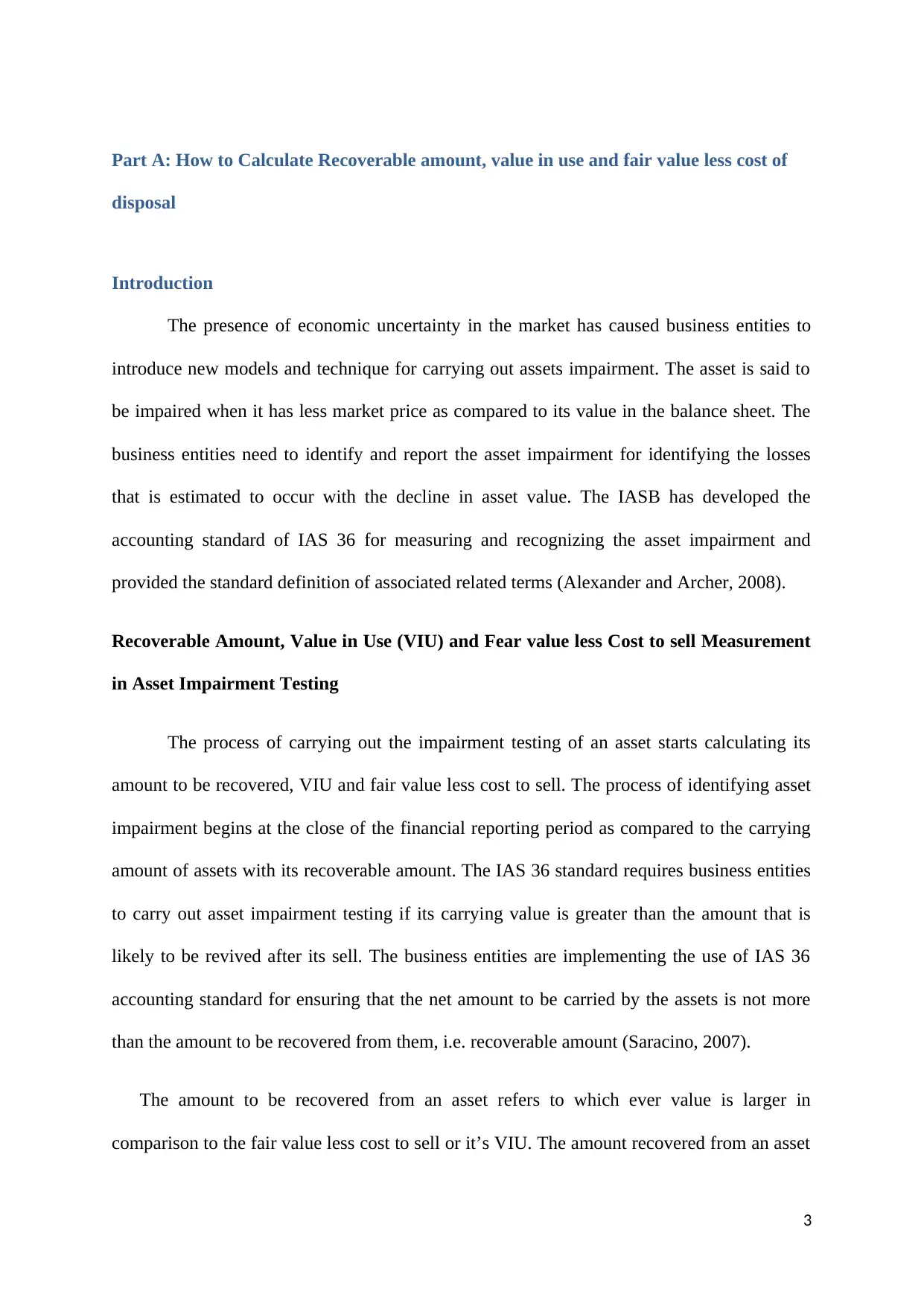
Part A: How to Calculate Recoverable amount, value in use and fair value less cost of
disposal
Introduction
The presence of economic uncertainty in the market has caused business entities to
introduce new models and technique for carrying out assets impairment. The asset is said to
be impaired when it has less market price as compared to its value in the balance sheet. The
business entities need to identify and report the asset impairment for identifying the losses
that is estimated to occur with the decline in asset value. The IASB has developed the
accounting standard of IAS 36 for measuring and recognizing the asset impairment and
provided the standard definition of associated related terms (Alexander and Archer, 2008).
Recoverable Amount, Value in Use (VIU) and Fear value less Cost to sell Measurement
in Asset Impairment Testing
The process of carrying out the impairment testing of an asset starts calculating its
amount to be recovered, VIU and fair value less cost to sell. The process of identifying asset
impairment begins at the close of the financial reporting period as compared to the carrying
amount of assets with its recoverable amount. The IAS 36 standard requires business entities
to carry out asset impairment testing if its carrying value is greater than the amount that is
likely to be revived after its sell. The business entities are implementing the use of IAS 36
accounting standard for ensuring that the net amount to be carried by the assets is not more
than the amount to be recovered from them, i.e. recoverable amount (Saracino, 2007).
The amount to be recovered from an asset refers to which ever value is larger in
comparison to the fair value less cost to sell or it’s VIU. The amount recovered from an asset
3
disposal
Introduction
The presence of economic uncertainty in the market has caused business entities to
introduce new models and technique for carrying out assets impairment. The asset is said to
be impaired when it has less market price as compared to its value in the balance sheet. The
business entities need to identify and report the asset impairment for identifying the losses
that is estimated to occur with the decline in asset value. The IASB has developed the
accounting standard of IAS 36 for measuring and recognizing the asset impairment and
provided the standard definition of associated related terms (Alexander and Archer, 2008).
Recoverable Amount, Value in Use (VIU) and Fear value less Cost to sell Measurement
in Asset Impairment Testing
The process of carrying out the impairment testing of an asset starts calculating its
amount to be recovered, VIU and fair value less cost to sell. The process of identifying asset
impairment begins at the close of the financial reporting period as compared to the carrying
amount of assets with its recoverable amount. The IAS 36 standard requires business entities
to carry out asset impairment testing if its carrying value is greater than the amount that is
likely to be revived after its sell. The business entities are implementing the use of IAS 36
accounting standard for ensuring that the net amount to be carried by the assets is not more
than the amount to be recovered from them, i.e. recoverable amount (Saracino, 2007).
The amount to be recovered from an asset refers to which ever value is larger in
comparison to the fair value less cost to sell or it’s VIU. The amount recovered from an asset
3
⊘ This is a preview!⊘
Do you want full access?
Subscribe today to unlock all pages.

Trusted by 1+ million students worldwide
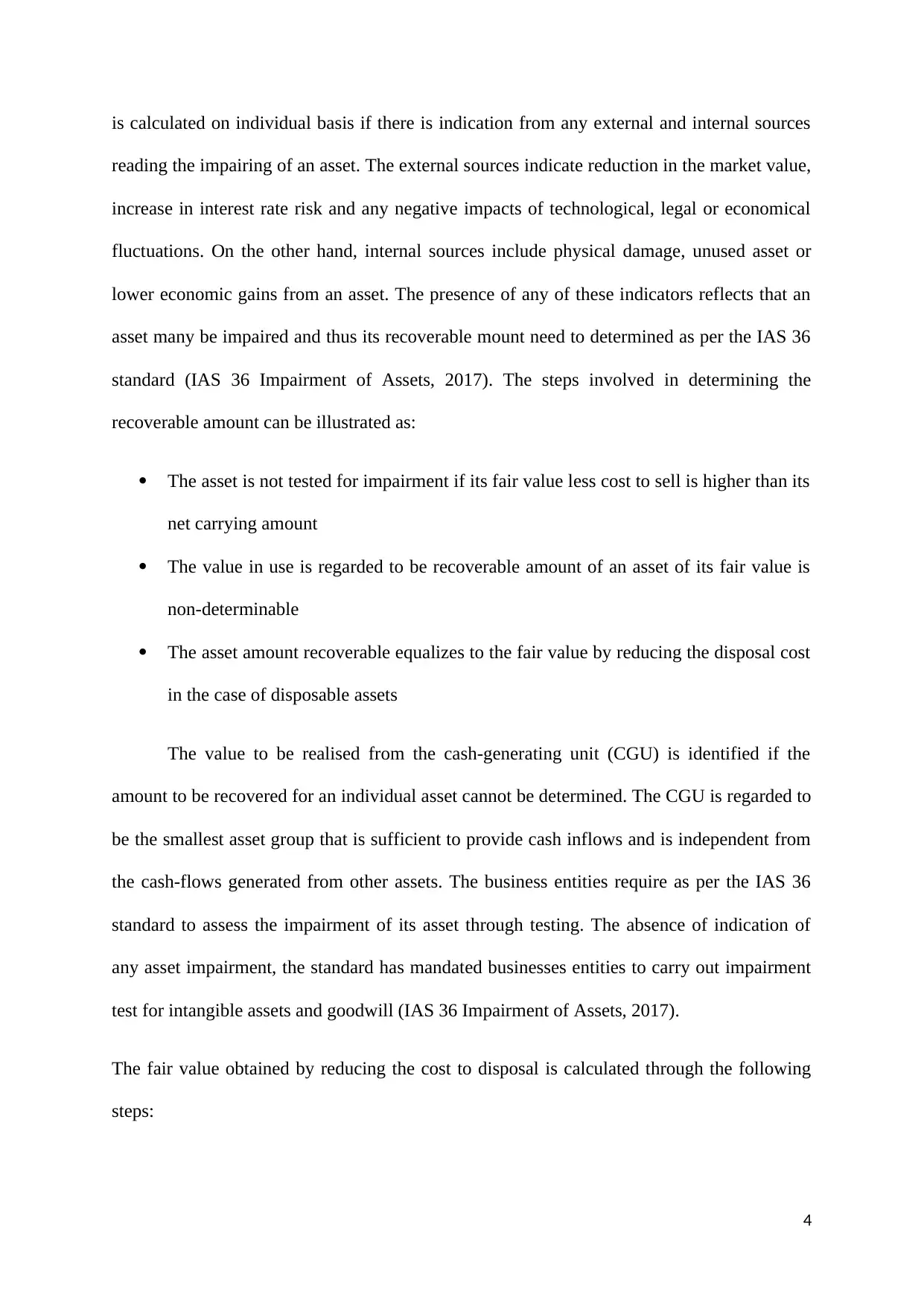
is calculated on individual basis if there is indication from any external and internal sources
reading the impairing of an asset. The external sources indicate reduction in the market value,
increase in interest rate risk and any negative impacts of technological, legal or economical
fluctuations. On the other hand, internal sources include physical damage, unused asset or
lower economic gains from an asset. The presence of any of these indicators reflects that an
asset many be impaired and thus its recoverable mount need to determined as per the IAS 36
standard (IAS 36 Impairment of Assets, 2017). The steps involved in determining the
recoverable amount can be illustrated as:
The asset is not tested for impairment if its fair value less cost to sell is higher than its
net carrying amount
The value in use is regarded to be recoverable amount of an asset of its fair value is
non-determinable
The asset amount recoverable equalizes to the fair value by reducing the disposal cost
in the case of disposable assets
The value to be realised from the cash-generating unit (CGU) is identified if the
amount to be recovered for an individual asset cannot be determined. The CGU is regarded to
be the smallest asset group that is sufficient to provide cash inflows and is independent from
the cash-flows generated from other assets. The business entities require as per the IAS 36
standard to assess the impairment of its asset through testing. The absence of indication of
any asset impairment, the standard has mandated businesses entities to carry out impairment
test for intangible assets and goodwill (IAS 36 Impairment of Assets, 2017).
The fair value obtained by reducing the cost to disposal is calculated through the following
steps:
4
reading the impairing of an asset. The external sources indicate reduction in the market value,
increase in interest rate risk and any negative impacts of technological, legal or economical
fluctuations. On the other hand, internal sources include physical damage, unused asset or
lower economic gains from an asset. The presence of any of these indicators reflects that an
asset many be impaired and thus its recoverable mount need to determined as per the IAS 36
standard (IAS 36 Impairment of Assets, 2017). The steps involved in determining the
recoverable amount can be illustrated as:
The asset is not tested for impairment if its fair value less cost to sell is higher than its
net carrying amount
The value in use is regarded to be recoverable amount of an asset of its fair value is
non-determinable
The asset amount recoverable equalizes to the fair value by reducing the disposal cost
in the case of disposable assets
The value to be realised from the cash-generating unit (CGU) is identified if the
amount to be recovered for an individual asset cannot be determined. The CGU is regarded to
be the smallest asset group that is sufficient to provide cash inflows and is independent from
the cash-flows generated from other assets. The business entities require as per the IAS 36
standard to assess the impairment of its asset through testing. The absence of indication of
any asset impairment, the standard has mandated businesses entities to carry out impairment
test for intangible assets and goodwill (IAS 36 Impairment of Assets, 2017).
The fair value obtained by reducing the cost to disposal is calculated through the following
steps:
4
Paraphrase This Document
Need a fresh take? Get an instant paraphrase of this document with our AI Paraphraser

The fair value is determined as per the IFRS 13 standard regarding the fair value
measurement
The cost of disposal are the added costs that are directly added and does not include
any existing costs or overhead
The fair value of an asset refers to the price that is realized by its selling or is paid
through transference of a liability in an ordered transaction. As such, it depicts the real price
of assets and liabilities by taking into account the market fluctuations. Thus, as per the IFRS
standards, the fair value of an asset can be stated as the market price of an asset that is
tradable and denotes the value of en entity assets or liabilities. As such, ‘the fair value less
cost to sell’ can be regarded as the value that would be realized from an asset sale by
deducting all the costs involved in carrying out its selling transaction (Impairment accounting
– the basics of IAS 36 Impairment of Assets, 2010).
The ‘value in use’ of an asset is calculated by measuring the present value of estimated
cash flows that will be realized from an asset. However, it is very difficult for calculating the
asset price that is in use as it is rather difficult to determine the profits to be realized from an
asset in future. The VIU of an asset can be measured through discounting the future cash
flows rising from the sale of an asset. The estimation of potential cash inflows realised
through selling an asset is rather difficult as it is entirely based on assumptions. The
discounted rate that is used in calculating the asset value in use should be a pre-tax rate
reflecting the recent predictions about the market situations (Weil, Schipper and Francis,
2011). Also, the entity should only include the future cash inflows resulting from the asset
restructure such as enhancing its performance to which it is still not committed. In addition to
this, the financial activities such as income tax receipts or payments received should not be
included in the potential cash flows estimation of an asset (Impairment of Assets, 2007).
5
measurement
The cost of disposal are the added costs that are directly added and does not include
any existing costs or overhead
The fair value of an asset refers to the price that is realized by its selling or is paid
through transference of a liability in an ordered transaction. As such, it depicts the real price
of assets and liabilities by taking into account the market fluctuations. Thus, as per the IFRS
standards, the fair value of an asset can be stated as the market price of an asset that is
tradable and denotes the value of en entity assets or liabilities. As such, ‘the fair value less
cost to sell’ can be regarded as the value that would be realized from an asset sale by
deducting all the costs involved in carrying out its selling transaction (Impairment accounting
– the basics of IAS 36 Impairment of Assets, 2010).
The ‘value in use’ of an asset is calculated by measuring the present value of estimated
cash flows that will be realized from an asset. However, it is very difficult for calculating the
asset price that is in use as it is rather difficult to determine the profits to be realized from an
asset in future. The VIU of an asset can be measured through discounting the future cash
flows rising from the sale of an asset. The estimation of potential cash inflows realised
through selling an asset is rather difficult as it is entirely based on assumptions. The
discounted rate that is used in calculating the asset value in use should be a pre-tax rate
reflecting the recent predictions about the market situations (Weil, Schipper and Francis,
2011). Also, the entity should only include the future cash inflows resulting from the asset
restructure such as enhancing its performance to which it is still not committed. In addition to
this, the financial activities such as income tax receipts or payments received should not be
included in the potential cash flows estimation of an asset (Impairment of Assets, 2007).
5

Conclusion
Thus, it can be inferred from the overall essay that the process of impairment of an
asset involves calculating its recoverable amount, fair value by reducing its disposal cost and
VIU. The identification of impaired asset is essential for an entity to plan in advance against
the impairment losses to be incurred from the asset sue in future. The impairment loss refers
to the increase in its carried value over the amount which is to be recovered. The loss arising
from asset impairment is stated in the profit and loss statement of a business entity. The IAS
36 standard has provides the standard guidelines ad principles that should be followed by a
business entity for identifying and measuring the assets impairment.
6
Thus, it can be inferred from the overall essay that the process of impairment of an
asset involves calculating its recoverable amount, fair value by reducing its disposal cost and
VIU. The identification of impaired asset is essential for an entity to plan in advance against
the impairment losses to be incurred from the asset sue in future. The impairment loss refers
to the increase in its carried value over the amount which is to be recovered. The loss arising
from asset impairment is stated in the profit and loss statement of a business entity. The IAS
36 standard has provides the standard guidelines ad principles that should be followed by a
business entity for identifying and measuring the assets impairment.
6
⊘ This is a preview!⊘
Do you want full access?
Subscribe today to unlock all pages.

Trusted by 1+ million students worldwide
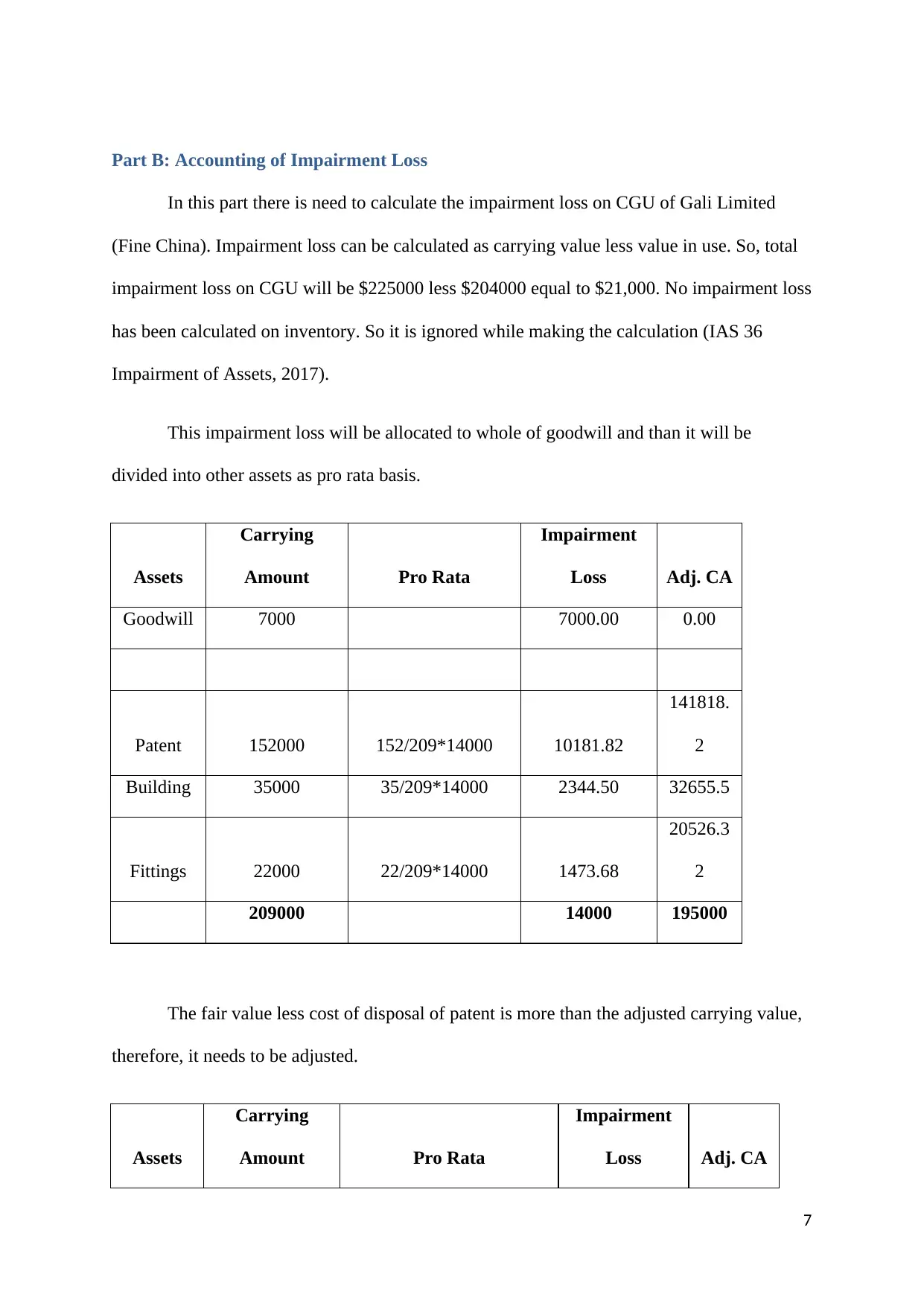
Part B: Accounting of Impairment Loss
In this part there is need to calculate the impairment loss on CGU of Gali Limited
(Fine China). Impairment loss can be calculated as carrying value less value in use. So, total
impairment loss on CGU will be $225000 less $204000 equal to $21,000. No impairment loss
has been calculated on inventory. So it is ignored while making the calculation (IAS 36
Impairment of Assets, 2017).
This impairment loss will be allocated to whole of goodwill and than it will be
divided into other assets as pro rata basis.
Assets
Carrying
Amount Pro Rata
Impairment
Loss Adj. CA
Goodwill 7000 7000.00 0.00
Patent 152000 152/209*14000 10181.82
141818.
2
Building 35000 35/209*14000 2344.50 32655.5
Fittings 22000 22/209*14000 1473.68
20526.3
2
209000 14000 195000
The fair value less cost of disposal of patent is more than the adjusted carrying value,
therefore, it needs to be adjusted.
Assets
Carrying
Amount Pro Rata
Impairment
Loss Adj. CA
7
In this part there is need to calculate the impairment loss on CGU of Gali Limited
(Fine China). Impairment loss can be calculated as carrying value less value in use. So, total
impairment loss on CGU will be $225000 less $204000 equal to $21,000. No impairment loss
has been calculated on inventory. So it is ignored while making the calculation (IAS 36
Impairment of Assets, 2017).
This impairment loss will be allocated to whole of goodwill and than it will be
divided into other assets as pro rata basis.
Assets
Carrying
Amount Pro Rata
Impairment
Loss Adj. CA
Goodwill 7000 7000.00 0.00
Patent 152000 152/209*14000 10181.82
141818.
2
Building 35000 35/209*14000 2344.50 32655.5
Fittings 22000 22/209*14000 1473.68
20526.3
2
209000 14000 195000
The fair value less cost of disposal of patent is more than the adjusted carrying value,
therefore, it needs to be adjusted.
Assets
Carrying
Amount Pro Rata
Impairment
Loss Adj. CA
7
Paraphrase This Document
Need a fresh take? Get an instant paraphrase of this document with our AI Paraphraser

Plant
146909.0
0
Equipme
nt 32655.50
32655.50/53181.82*5090.
82 3125.94 29529.56
Fittings 20526.32
20526.32/53181.82*5090.
82 1964.88 18561.44
53181.82 5090.82
195000.0
0
Calculation of total Impairment
Assets Carrying Amount Impairment Loss Adj. CA
Goodwill
$
7,000.00
$
7,000.00
$
-
Patent
$
152,000.00
$
5,091.00
$
146,909.00
Building
$
35,000.00
$
5,470.44
$
29,529.56
Fittings
$
22,000.00
$
3,438.56
$
18,561.44
$
216,000.00
$
195,000.00
Journal Entries
Impairment loss on assets of CGU Dr $ 21000.00
8
146909.0
0
Equipme
nt 32655.50
32655.50/53181.82*5090.
82 3125.94 29529.56
Fittings 20526.32
20526.32/53181.82*5090.
82 1964.88 18561.44
53181.82 5090.82
195000.0
0
Calculation of total Impairment
Assets Carrying Amount Impairment Loss Adj. CA
Goodwill
$
7,000.00
$
7,000.00
$
-
Patent
$
152,000.00
$
5,091.00
$
146,909.00
Building
$
35,000.00
$
5,470.44
$
29,529.56
Fittings
$
22,000.00
$
3,438.56
$
18,561.44
$
216,000.00
$
195,000.00
Journal Entries
Impairment loss on assets of CGU Dr $ 21000.00
8

To Goodwill $7000.00
To Impairment Loss Patent $5091.00
To Impairment Loss Building $5470.44
To Impairment Loss fittings $3438.56
9
To Impairment Loss Patent $5091.00
To Impairment Loss Building $5470.44
To Impairment Loss fittings $3438.56
9
⊘ This is a preview!⊘
Do you want full access?
Subscribe today to unlock all pages.

Trusted by 1+ million students worldwide
1 out of 9
Related Documents
Your All-in-One AI-Powered Toolkit for Academic Success.
+13062052269
info@desklib.com
Available 24*7 on WhatsApp / Email
![[object Object]](/_next/static/media/star-bottom.7253800d.svg)
Unlock your academic potential
Copyright © 2020–2025 A2Z Services. All Rights Reserved. Developed and managed by ZUCOL.





